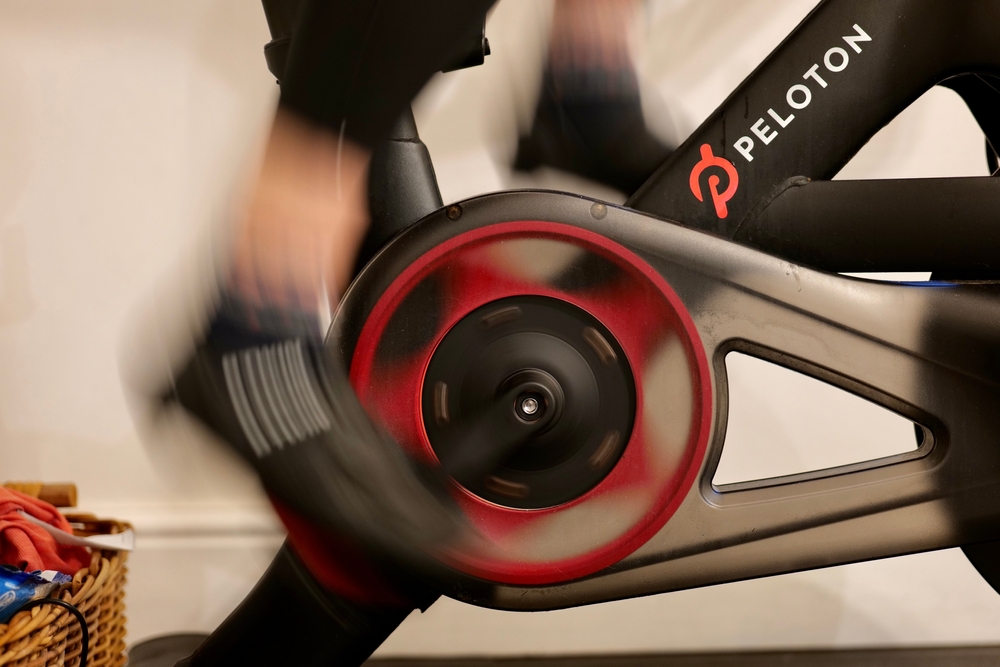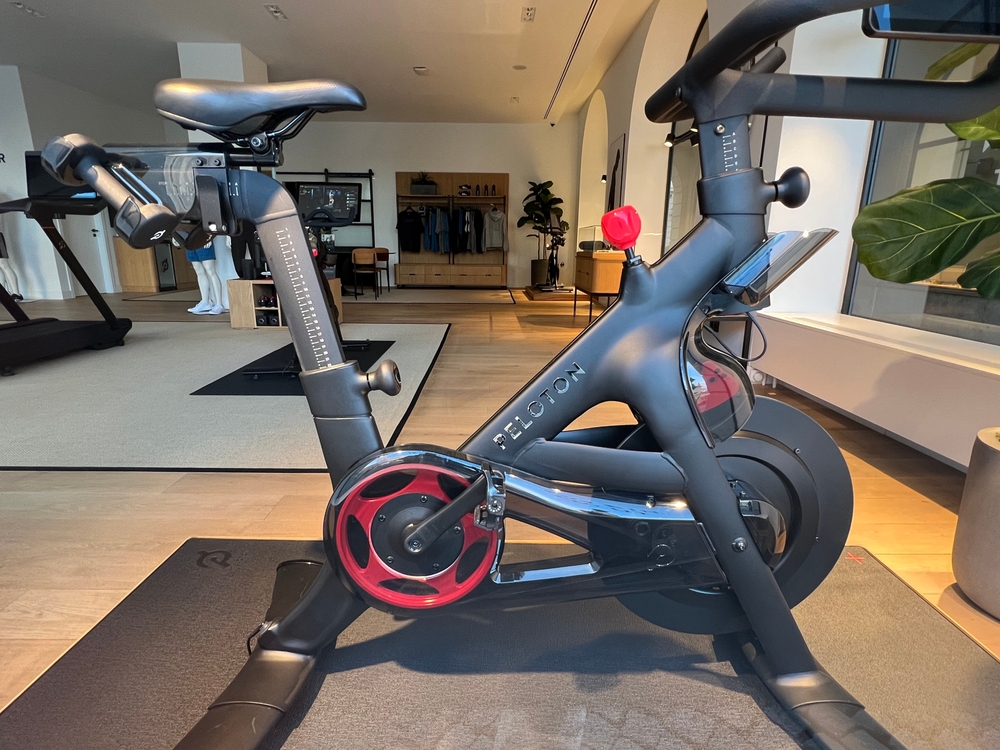Peloton is one of the best ways to lose weight and get into the best shape of your life. Their innovative and technologically integrated approach is accessible and effective, providing both an excellent exercise regimen and personalized data to track progress. One of the best ways to tackle your fitness and get into great shape is by using Peloton Power Zone training.
Peloton Power Zone training is an excellent way to lose weight and improve athletic performance. Power Zone rides require riders to move between 7 unique zones. Each zone indicates a different level of power output, requiring different levels of effort. Peloton automatically calculates your Power Zones and displays them during each ride. The best rides include Endurance and Power Zone.
Interest in starting your Power Zone journey? Read on for tips on getting started today!
Contents
- How Much Weight Can You Lose on Peloton?
- Are Peloton Power Zone Rides Good for Weight Loss?
- How Long Can You Ride Each Power Zone?
- How Is Peloton Power Zone Calculated?
- Peloton Power Zone Training Benefits
- Power Zone vs. Heart Rate Zone
- Best Peloton Power Zone Rides
- Peloton Power Zone Training Schedule
- Peloton Power Zone Test
- Power Zone Training Tips
How Much Weight Can You Lose on Peloton?
Peloton classes burn anywhere from 400 to 1,000 calories per hour. Combined with a healthy diet, you will hit your weight goals in a matter of months.
Completing Peloton Power Zone training 3 to 5 times a week will greatly assist your efforts to lose weight. However, fitness is not just exercise, but the combination of all your efforts. You will never out-exercise a poor diet. Be sure to give yourself the best chance for success by incorporating healthy eating habits and nutrition into your lifestyle as well.
Regular exercise and a well-balanced diet are the best ways to reach your weight goals in the quickest, healthiest possible way.
How Many Times a Week Should I Ride My Peloton to Lose Weight?
If you are a beginner, it may be adequate to ride 2 to 3 times weekly. For novice or advanced riders, 5 to 6 rides weekly will work wonders for your fitness goals.
Remember to take rest days in between training days. If you are only budgeting 1 or 2 rest days, that’s fine, but be sure some training days are lighter or easier. Going hard every day will not put you in the fast lane to weight loss. Conversely, it will actually hurt your results and your performance.
Are Peloton Power Zone Rides Good for Weight Loss?
Peloton Power Zone rides are good for weight loss.
During any cardio exercise, the optimal fat burn and weight loss zone is approximately 70-80% of your max heart rate. Power Zone rides aren’t necessarily prioritizing your heart rate zones, but they’re still structured to keep you in the right range.
Since instructors call out different zones during the ride, you’re constantly adjusting your effort level. This causes your heart rate to fluctuate between slightly elevated to significantly challenged. The result will keep you in that sweet spot to get the best weight loss benefits during the ride.
Peloton Power Zone rides combine the best parts of HIIT and heart rate zones in one neat package, making it great for weight loss.
List of Peloton Power Zones
To reap the most reward from Power Zone training, you must use each zone as intended. The zones are as follows:
| Zone | Effort Level |
|---|---|
| 1 | Very Easy |
| 2 | Moderate |
| 3 | Sustainable |
| 4 | Challenging |
| 5 | Hard |
| 6 | Very Hard |
| 7 | Max Effort |
Zone 1 is the active recovery zone. Instructors will send you to Zone 1 pretty infrequently, after intense bouts of effort or for a cooldown only.
Zone 2 is the endurance zone. As with most endurance-oriented exercise, your aim is to sustain the pace and output for the long term.
Zone 3 is the tempo zone. Things are starting to ramp up, but you could feasibly still have a conversation. You probably won’t want to, but you could if you really had to.
Zone 4 is the lactate threshold. In this zone, we’ve now hit the tipping point. Your body can no longer eliminate lactic acid as it builds. From here on out, you’ll need to slow down or stop to recover.
Zone 5 is the VO2 max threshold. Your VO2 max refers to the volume of oxygen in your lungs. In layman’s terms, it’s when you start breathing heavily during exercise. Exercising in Zone 5 will challenge your breathing but provide cardiovascular benefits over time.
Zone 6 is the anaerobic threshold. At this point, you’re pushing to move faster than your body can efficiently allow. Consider it a near sprint.
Zone 7 is the neuromuscular power threshold. This is an all-out sprint. You’ll be moving much faster and pushing harder than your body can sustain. If you can manage to get a few seconds in this zone, that’s enough.
How Long Can You Ride Each Power Zone?
To get the best results from Peloton Power Zone training, you need to use the zones properly. If you are significantly above or below, you should retest your FTP before training further.
For instance, if you can stay in Zone 7 for a full minute, your numbers are wrong. Likewise, if you are finding it hard to reach Zone 4 or 5, you may need new numbers as well.
Here is each zone and approximately how long you should be able to remain there.
| Zone | Duration |
|---|---|
| 1 | All day |
| 2 | 3 or more hours |
| 3 | 20 to 60 minutes |
| 4 | 10 to 60 minutes |
| 5 | 3 to 15 minutes |
| 6 | 30 seconds to 3 minutes |
| 7 | Less than 30 seconds |
How Is Peloton Power Zone Calculated?
Peloton automatically calculates your Power Zones for you and displays them during each ride if you’re on a Peloton bike. This is really helpful when the training really gets tough. Who can do math and ride at the same?
If you’re not on a Peloton bike, you have to do some math.
Here’s how to calculate your Power Zones manually:
- Take the 20-Min FTP Test Ride.
- Record your “average output” number from the recap screen.
- Subtract 5% from “average output” and round up to the nearest whole number. This is your “FTP.”
- Multiply FTP by percentage range for each Power Zone.
- Record all numbers and keep them handy!
Here are the percentage range for each zone:
| Zone | Percentage Range |
|---|---|
| 1 | <55% |
| 2 | 56-75% |
| 3 | 76-90% |
| 4 | 91-105% |
| 5 | 106-120% |
| 6 | 121-150% |
| 7 | >151% |
The idea here is that your FTP is that sweet spot before you start to fatigue quickly. Zones below 100% of your FTP are designed to provide steady state cardio or active recovery. Zones at or above 100% of your FTP are designed to challenge you. You will not be able to sustain Zones 6 or 7 for more than a few seconds. If you are, you should start from step 1 and recalculate your numbers.
Peloton Power Zone Training Benefits
There’s a lot to love about Peloton Power Zone training.
It’s engaging.
Grinding can be a drag. It’s hard to hit your goals when you barely want to hit the saddle in the first place. Peloton Power Zone training requires you to get into the zone and keep yourself there. It’s kind of like a fitness game, and the winner is always you!
It provides a benchmark goal.
Many people get into the gym to lose weight or “get in shape.” This sometimes leaves the parameters vague, and it’s hard to tell if you’re making progress or not. Peloton Power Zone training is all about hitting your zones, and the zones are based on that all-important FTP.
Peloton recommends retesting your FTP every 6 to 8 weeks. By updating your FTP regularly, it keeps the zones challenging to your ability level so the gains can keep coming. This gives you a definitive timeline and a definitive number to improve.
Trying to improve your FTP helps provide a goal beyond the standard staring at the scale we all find ourselves victim to sometimes. Luckily, the work you do to improve your FTP will translate to other benefits as well.
It’s personalized.
Another huge benefit of Peloton Power Zone training over other training is that it is personalized to you. Your zones are your zones. Everyone in class has a different FTP and will therefore be pedaling at different speeds and resistance levels. Nonetheless, everyone is hitting that perfect zone to get the same type of result.
Even though your focus is on your zone and your output, the specifics are specific to you. No matter what ability level you’re at, you will always get a great workout with a regularly updated FTP.
Power Zone vs. Heart Rate Zone
Studies show that power zone training is superior to heart rate zone training.
Let’s explore why.
Power refers to the work you’re doing during the workout. The speed at which you’re pedaling and the resistance you are managing contribute to a power output. This number is exact. The work is what the work is. Period.
Heart rate is more finicky. Other outside factors can contribute to wacky readings, including fatigue, hydration, or temperature. When you’re performing work, it also takes some time for your heart rate to increase in response to it. That means there’s a lag. You are doing work at an increased power level, but your heart rate is yet to reflect it.
This by no means indicates that heart zone training is ineffective. It has many benefits. However, power zone training has similar benefits. Plus, it’s easier to stay in the right zone for the right duration due to how power is measured.
Best Peloton Power Zone Rides
There are a number of Peloton Power Zone rides based on your ability and goals.
Beginner, Warm-Up, and Test Rides
Peloton offers a number of beginner, warm-up, or test rides, including the crucial 20-Min FTP Test Ride. Beginner and warm-up rides are very easy or moderate in intensity. They’re usually geared towards familiarizing riders with the format of Power Zone training or active recovery.
The 20-Min FTP Test Ride, on the other hand, is a critical component of all future Power Zone rides. Make sure you understand the basics before giving it a shot.
Endurance
Endurance rides are the basic, straightforward, simple ones that mostly have you riding in Zone 3 with occasional, moderate spurts. As the name suggests, it’s intended to build endurance.
Regularly completing Endurance rides will improve your ability to ride for longer periods.
Power Zone
Power Zone rides are the mid-tier option that will get you going between Zones 3 and 6 mostly. Unlike Endurance, instructors will vary the zone more often to keep things dynamic. This provides more fat burning and cardio benefits versus Endurance.
These rides are more intense than Endurance rides, and therefore they’re often more challenging.
Power Zone Max
Power Zone Max rides are the most challenging of the bunch, and the only ones that throw Zone 7 your way. You’ll never spend long in Zone 7, since it’s literally exhausting, but including it offers significant cardiovascular upside.
These rides are for advanced riders and will provide great benefits to your overall cardiovascular abilities and strength.
Peloton Power Zone Training Schedule
Peloton Power Zone training is very effective. How often your ride should depend on a few different factors:
- Your goals– Are you trying to lose a little bit of extra weight, or improve your athleticism? What you want to accomplish will dictate how often you should ride and at what intensity.
- Other training– Is your only workout Peloton Power Zone training, or are you also running? Are you lifting? Are you doing calisthenics or other full body workouts during the week? You will be able to do Peloton more often if it’s the only thing you’re doing.
- Your schedule– Can you commit to getting in the zone multiple times a week? Sometimes our schedules preclude us from being as consistent as we should be.
Assuming this is your main training method, you could probably get in 3 to 6 rides each week. Make sure you vary the type of ride and intensity to give yourself adequate rest in between rides. For example:
| Day | Ride |
|---|---|
| Sunday | Endurance |
| Monday | Power Zone |
| Tuesday | Rest |
| Wednesday | Power Zone |
| Thursday | Rest |
| Friday | Power Zone Max |
| Saturday | Rest |
As you build a solid fitness foundation, you could easily nix one of the rest days and add an additional training day. Just be sure to include Endurance for active recovery or rest before and/or after Power Zone Max. Your body will thank you for it.
Peloton Power Zone Test
Before you can make use of Power Zone training, you’ll need to take the 20-Min FTP Test Ride.
FTP stands for Functional Threshold Power. It is a number that refers to your average power output over the course of an hour. All Power Zones will be determined by this number.
We recommend trying some warm-ups, including the 10-Min Power Zone Warm-Up Ride. The Warm-Up ride will familiarize you with power zone training. You will have a chance to get practice and try tactics that will lead you to a better FTP during the Test Ride.
When you do take the 20-Min FTP Test Ride, don’t sweat the results! It’s supposed to indicate your current fitness level, so testing and retesting to appear more fit is counterintuitive. Instead, embrace your result, use it for 6 to 8 weeks, and retest then to see how far you’ve come.
Power Zone Training Tips
Peloton Power Zone training is very effective. It’s tempting to want to jump in and go full throttle to start enjoying results immediately. However, there are some things to keep in mind when putting Power Zone training into practice.
Keep in mind the following tips to ensure you get the best results:
- Stay in the zone– It’s tempting to go hard when you’re feeling strong or motivated. However, the effectiveness of Power Zone training lies in being in the right place at the right time for the right duration. Regularly overdoing things or working harder than the workout calls for will be detrimental and is counterintuitive to the training philosophy. Likewise, failing to get into the correct zone will shortchange you and your results. Follow the instructor’s cues and stay in the right zone when it’s called out.
- Be honest with yourself– If you and your friend share FTP numbers and yours feels less impressive, you might want to exaggerate. Do what you want interpersonally, but don’t lie to yourself. If you think you need to be working harder, don’t manually adjust your FTP. Retest and let Peloton determine your appropriate zones. You’ll only hinder progress by going too hard too soon.
- Vary your rides– You’ll get really good at Endurance if you exclusively do Endurance. However, your cardiovascular output and VO2 max will get no benefit if you never move beyond Zones 4 or 5. Try throwing in some Power Zone and Power Zone Max to keep the gains coming progressively.
- Rest when you need– This is a tidbit that applies to any training regimen. Be sure to factor in rest days 2 to 3 times a week, even if you feel great. Overtraining is real and can cause serious health problems or injury.






